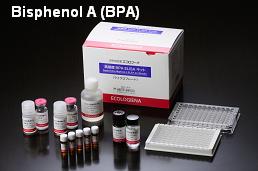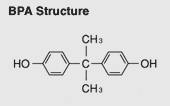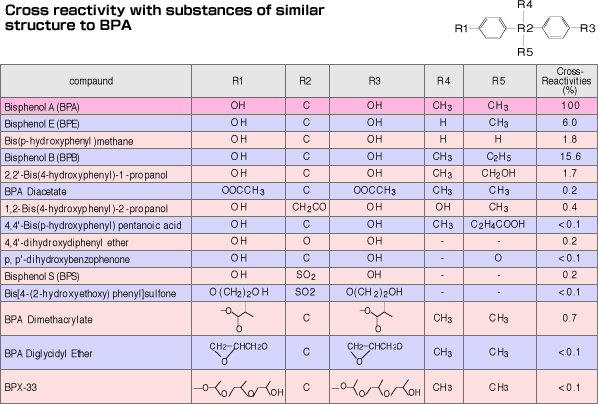 supersensitive BPA ELISA Kit supersensitive BPA ELISA Kit |
 Bisphenol
A (BPA), principal raw material for polycarbonate and epoxy resins,
is suspected as one of the endocrine disrupting chemicals. Bisphenol
A (BPA), principal raw material for polycarbonate and epoxy resins,
is suspected as one of the endocrine disrupting chemicals.
GC/MS, generally employed methods for quantitative BPA analysis,
requires expensive instrumentation as well as complex and time-consuming
extraction process with hazardous organic solvent.
 This test kit detects BPA in environment or in vitro
with high sensitivity with the aid of solid phase extraction. This test kit detects BPA in environment or in vitro
with high sensitivity with the aid of solid phase extraction.
Features
- The quantitative analysis ranges from 0.05-10μg/L(ppb), sensitive enough
to detect BPA in a specimen from river water, etc..
- A simple solid phase extraction is available
to measure samples with lower concentration.
- The total time for measurement is only 2.5 hours.
- BPA monoclonal antibody binds exclusively with BPA and does
not show cross-reaction with other chemicals with similar structures.
- The amount of harmful solvent can be minimized.
| Standard Curve of BPA |
|
|
| Cross-Reactivity Pattern |
| Compounds |
Cross Reactivity(%) |
| Bisphenol A (BPA) |
100 |
| Diethylhexylphthalate (DEHP) |
<0.05 |
| Nonylphenol (NP) |
0.19 |
| 17β-Estradiol (E2) |
<0.05 |
| Estrone (E1) |
<0.05 |
| Linear alkylbenzene sulfonate (LAS) |
<0.05 |
| Alkylphenol Ethoxylate (APE) |
<0.05 |
| Alkyl Ethoxylate (AE) |
<0.05 |
| Humic acid Na |
<0.05 |
|
| . |

Kit Format
| Kit Format |
Comment |
| Microplate |
1 plate (96 wells)& reagents |
Needs a microplate reader (450nm)
For multiple and simultaneous measurement |
Simple Solid Phase
Extraction (example)
- Adjust the pH of the sample to 3.5 with 1M HCl.
- Wash out C18 solid phase cartridge with MeOH and distilled
water; then pour the sample through the cartridge.
- Rinse the cartridge with water, then elute the mixture of
aceton and MeOH at the ratio of 1:1.
- Dry the sample with nitrogen gas, then adjust MeOH concentration
at 10% for measurement.
For research use only. Not for diagnostic use.
|